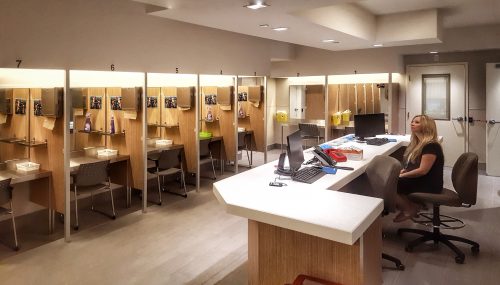3rd October 2023
This article first appeared in The Conversation. This article is written by James Nicholls, the previous Chief Executive Officer of Transform Drug Policy Foundation.
On the basis of the information I have been provided, I would be prepared to publish a prosecution policy that it would not be in the public interest to prosecute drug users for simple possession offences committed within a pilot safer drugs consumption facility.
Dorothy Bain KC, Lord Advocate of Scotland
Scotland’s most senior law officer, the Lord Advocate, has released a statement that would enable NHS Glasgow and Clyde to open a safer drug consumption facility (SDCF) in the city.
Also known as overdose prevention centres, SDCFs are spaces where people can take their own drugs under supervision. The main purpose is to provide access to a safe environment and clean equipment, and to ensure that accidental overdoses are tackled quickly and effectively. They also provide non-judgmental settings where people who use drugs can access wider support or be directed to other services.
More than 200 SDCFs currently operate globally, and a significant body of research demonstrates their impact on a range of harms. However, with the exception of an unsanctioned mobile facility that operated in Glasgow in 2019-20, none have been opened in the UK.
This is primarily because, under the Misuse of Drugs Act 1971, possession of controlled drugs is an offence. However, it also reflects a longstanding resistance within the UK government to harm reduction policies which it views as enabling substance use.
In recent years, the Scottish government sought to shift its policy focus by addressing drug harms as a public health issue, rather than a criminal justice matter. Scotland has some of the highest drug-related death rates in the world.
The reasons for this are complex, but the crisis has motivated a desire to take a new approach based on reducing the harms and stigma associated with drug use and engaging people who use drugs through proactive support. Safer consumption rooms are viewed by many as a critical element of this broader response.
Changing approaches to drug harms
Until now, however, legal barriers have blocked progress. Under primary UK-wide legislation, which has remained stubbornly fixed for more than 50 years, anyone using a safer consumption room could be arrested for possession, while operators could be charged with permitting or enabling use on their premises.
In 2017, following a report setting out the urgent need for safer injecting facilities, the Glasgow City Health and Social Care Partnership asked the then Lord Advocate to provide assurance that those involved in establishing or using these facilities would be protected from prosecution.
The request was declined on the basis that what it sought was too broad and beyond the remit of the Lord Advocate. Last year a new, narrower request was put to the current Lord Advocate, Dorothy Bain. This week’s statement is her formal response.
The new approach would clear the way for a pilot safer consumption room to be established in Glasgow by stating it would not be in the public interest to prosecute people using the facility. The Scottish secretary Alister Jack has since confirmed that “the UK government will not intervene” to prevent a safer consumption room being established.
This is a gamechanger.
An essential first step
The new initiative removes the key roadblock that has prevented the establishment of a safer consumption room in Glasgow, despite support from the Scottish government. It is of enormous significance and will be welcomed by many across the UK who believe these centres can play a vital role in tackling drug harms.
The terms of the Lord Advocate’s statement are, however, strictly constrained. It applies specifically to the Glasgow pilot and is based on assessment of its particular design, setting and operating procedures.
Many different types operate globally in countries including Australia, Germany, Spain and Canada. Some, like the one proposed for Glasgow, are closely integrated with existing medical services, while others adopt a more informal approach and employ more staff with an experience and history of drugs themselves.
Some research suggests that flexible, peer-led approaches are attractive to the people most likely to benefit from safer consumption rooms, so there is a good case for allowing additional pilots to assess which type would work best in Scotland. However, this will likely require further interventions from the Lord Advocate.
Nevertheless, this is a critical milestone. It finally allows us to assess the degree to which these centres can contribute to reducing harms in the UK; though it is important to remember that while safer consumption rooms have become a touchstone for often heated debate on drug policy reform, they can only provide part of a wider set of needed solutions.
The Lord Advocate has requested rigorous evaluation, which is to be welcomed. Much debate so far has hinged on global evidence for the effectiveness of these facilities, but it is vital that we develop an evidence base for the UK – and Scotland especially, where patterns of consumption and harm are often distinct – such as the widespread use of street valium (known as “benzos”), rising levels of cocaine injecting and associated spikes in rates of HIV transmission.
If we are to really understand the role safer consumption rooms can play in tackling drug harms, we need multiple pilots and evaluations. While limited in scope, this decision allows that process to begin – and should, based on what we know, help tackle many harms here and now. That is good news for everyone concerned.
Further reading
Drug Consumption Rooms and Public Health Policy: Perspectives of Scottish Strategic Decision-Makers




